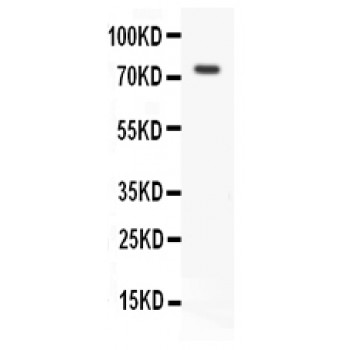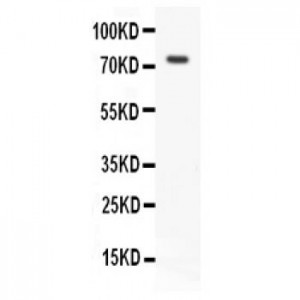More info
Overview
Long Name | Antibody Type | Antibody Isotype | Host | Species Reactivity | Validated Applications | Purification |
| receptor(TNFRSF)-interacting serine-threonine kinase 1 | Polyclonal | IgG | Rabbit | Human | WB | Immunogen affinity purified. |
Immunogen | ||||||
| A synthetic peptide corresponding to a sequence in the middle region of human RIP(411-425aa RRRRVSHDPFAQQRP). | ||||||
Properties
Form | Lyophilized |
Size | 100 µg/vial |
Contents | Antibody is lyophilized with 5 mg BSA, 0.9 mg NaCl, 0.2 mg Na2HPO4, 0.05 mg Thimerosal and 0.05 mg NaN3. *carrier free antibody available upon request. |
Concentration | Reconstitute with 0.2 mL sterile dH2O (500 µg/ml final concentration). |
Storage | At -20 °C for 12 months, as supplied. Store reconstituted antibody at 2-8 °C for one month. For long-term storage, aliquot and store at -20 °C. Avoid repeated freezing and thawing. |
Additional Information Regarding the Antigen
Gene | RIPK1 |
Protein | Receptor-interacting serine/threonine-protein kinase 1 |
Uniprot ID | Q13546 |
Function | Serine-threonine kinase which transduces inflammatory and cell-death signals (programmed necrosis) following death receptors ligation, activation of pathogen recognition receptors (PRRs), and DNA damage. Upon activation of TNFR1 by the TNF-alpha family cytokines, TRADD and TRAF2 are recruited to the receptor. Phosphorylates DAB2IP at 'Ser-728' in a TNF-alpha-dependent manner, and thereby activates the MAP3K5-JNK apoptotic cascade. Ubiquitination by TRAF2 via 'Lys-63'-link chains acts as a critical enhancer of communication with downstream signal transducers in the mitogen-activated protein kinase pathway and the NF-kappa-B pathway, which in turn mediate downstream events including the activation of genes encoding inflammatory molecules. Polyubiquitinated protein binds to IKBKG/NEMO, the regulatory subunit of the IKK complex, a critical event for NF-kappa-B activation. Interaction with other cellular RHIM-containing adapters initiates gene activation and cell death. RIPK1 and RIPK3 association, in particular, forms a necrosis-inducing complex. |
Tissue Specificity | |
Sub-cellular localization | Cytoplasm. Cell membrane . |
Sequence Similarities | Belongs to the protein kinase superfamily. TKL Ser/Thr protein kinase family. |
Aliases | Cell death protein RIP antibody|FLJ39204 antibody|OTTHUMP00000039163 antibody|Receptor(TNFRSF) interacting serine threonine kinase 1 antibody|receptor interacting protein 1 antibody|Receptor interacting protein antibody|Receptor interacting serine threonine protein kinase 1 antibody|Receptor TNFRSF interacting serine threonine kinase 1 antibody|Receptor-interacting protein 1 antibody|Receptor-interacting serine/threonine-protein kinase 1 antibody|Rinp antibody|RIP 1 antibody|RIP antibody|Rip-1 antibody|RIP1 antibody|RIPK 1 antibody|RIPK1 antibody|RIPK1_HUMAN antibody|Serine threonine protein kinase RIP antibody|Serine/threonine-protein kinase RIP antibody |
Application Details
| Application | Concentration* | Species | Validated Using** |
| Western blot | 0.1-0.5μg/ml | Human | AssaySolutio's ECL kit |
AssaySolution recommends Rabbit Chemiluminescent WB Detection Kit (AKIT001B) for Western blot. *Blocking peptide can be purchased at $65. Contact us for more information

Anti- RIP antibody, ASA-B1629, Western blotting
All lanes: Anti RIP (ASA-B1629) at 0.5ug/ml
WB: HELA Whole Cell Lysate at 40ug
Predicted bind size: 76KD
Observed bind size: 76KD
All lanes: Anti RIP (ASA-B1629) at 0.5ug/ml
WB: HELA Whole Cell Lysate at 40ug
Predicted bind size: 76KD
Observed bind size: 76KD



